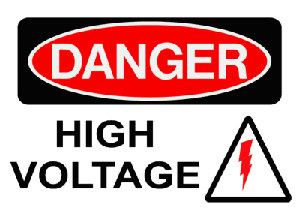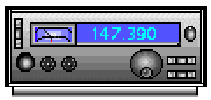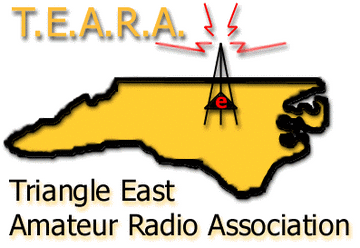It's The Volts That Jolts
And The Mils That Kills!

Norman Young
KA4PUV
Many
of us have high power HF amplifiers, CRT monitors, TV's, tube or hybrid
boatanchors and equipment, or other high voltage sources around the
shack. Since these items all have very high voltages under the
hood, we should have a very healthy respect for the potential (no pun
intended) harm that could result from an unintended close encounter
with such voltages.
The
following series of recent posts from the Yahoo! Kenwood
TS-520_820_530_830 reflector illustrate the very real danger involved
in tinkering with this kind of equipment. The idea is not that
you should
not work on your own stuff, but rather that you need to observe
reasonable safety precautions when you do. So with that in mind,
here are a few cautionary tales for your enjoyment. (NOTE:
These were copied directly from the reflector digest without
editing, except that personal identifying information was removed from
all posts.) - Ed.
DAY 1
2a.
My First HV Experience -- Shocking!
Greetings
Kenwood Aficionados. I feel that I should share this rather stupid
experience with you all. I recently had the RF board out of a 530, and
to do that one has to disconnect the shafts for the drive, plate, and
load. After I put it back together, I _did_ realize that the connectors
for the Plate shaft represent insulation between the HV and the shaft.
I did _not_ realize that the alignment of the shaft, where it sits in
the set-screws, is the only thing
that determines
whether or not the shaft extension is touching the
shaft of the plate tuning capacitor. So when I put it back
together I had the shaft extension touching the shaft of the
plate tuning capacitor. How did I find this out... the three-stooges
way of course. I had pulled the plug and was standing the chassis up on
it's side, and I was moving the speaker wire around to keep it out from
under the chassis. I poked the speaker wire up into the area of the
shafts,
and pressed the shaft. Fortunately the capacitors had been bleeding
down for a while, it had been less than a minute but more than fifteen
seconds. I had tested the HV on this radio earlier so I do know that
the bleeders are working. So I probably only got about half charge, but
it was very unpleasant. It definitely was the worst case scenario, went
in my left hand and across my body to my right hand where I was holding
the chassis. Made a nice burn mark on my
finger too.
I am
the most nervous person you know around HV, I have no experience
working with electrical equipment prior to getting into radio so I am
really very cautious. But I got shocked anyway, so I figure I might as
well share my tale with you all. It can happen to anyone, fortunately
no lasting effects for me. Be careful when you reconnect the shafts!
2b.
Re: My First HV Experience -- Shocking!
I
am very happy you are OK. Across the chest short is VERY bad as you are
aware. I am also very cautious around HV, but sometimes we get in
a hurry. I try to always use the one hand in my back pocket rule
when working around HV.
2c.
Re: My First HV Experience -- Shocking!
Glad you didn't get REALLY hurt.
This is what we, old "boatanchor" (tube radio) people call: "discipline by voltage"!
A jolt that wakes you up and teches (sic) you to keep one hand in the pocket when poking around high voltage...
2d.
Re: My First HV Experience -- Shocking!
I was an electrician in the Navy and we had a couple sayings...one being:
"Never trust your life to an electrician who's never been shocked before!"
Another being:
"There are old electricians and bold electricians...there are no old AND bold electricians.
You
were lucky and I'm certain you now FULLY apreciate the power of
electrons leaking into the human body...BTW, I still have an intersting
scar on my left index fingertip where an arc entered my finger many
years ago.
2e.
Re: My First HV Experience -- Shocking!
> This is what we, old "boatanchor" (tube radio) people call:
> "discipline by voltage"!
Or what I like to call "servicemans elbow"
My
first rig was a Yaesu FT-101E. Got to adjusting the TX and mistakenly
touched the 800V line. My elbow went into a concrete wall where the
shack was located at the time. So I stood there for a few minutes in
disbelief and then when back to the task at hand. And touched it again!
That was it...solid state for me from then on in, until I got older and
wiser.
2f.
Re: My First HV Experience -- Shocking!
I
got nailed long time ago with 2300 vac building my 2kw amp power
supply. Stupid, stupid, stupid. Using and open frame transformer, I
decided to see if the transformer was getting warm. Well, slid my had
right up to the exposed winding and touched it.
Laying on the
floor, my first reaction was to see if I was still breathing. Yep I
was. So, I layed there for a while to recuperate but my are hurt like
hell. Felt like someone whacked me in the upper arm with a baseball bat.
I'm fortunately here to tell this story.
2g.
Re: My First HV Experience -- Shocking!
That makes my episode equivalent to sticking your tongue on a 9V battery!!
2h.
Re: My First HV Experience -- Shocking!
I
feel for you ***, be careful, I getting a very old boat weight, and
getting on the air real soon! You were very VERY Lucky, ***! I don't
know how much voltage and current you got, but lucky you are, doing
some researched on how much it take to defeb your heart, 900 ma's, take
care of yourself, when you work on it in the future have some one with
you, next time you might not be so lucky!!! :-)
600 VDC in
considered deadly, so with 900 ma's, YOU CAN DIE! My Tempo One not a
Kenwood has 1000 VDC on the plate, a pair of 6JS6A's, this would be
deadly very likely
2i.
Re: My First HV Experience -- Shocking!
My
first was grabbing hold of either side of a neon sign in a restaurant
at the age of 3. Wet hands (badly burned), tennis shoes (melted to the
floor), and that's all I remember until I was about 5. My second was in
a college electronics course aligning a tube style AM broadcast
receiver. I steadied the plastic case with one hand, stuck in the
O-scope probe with the other and wound up bouncing off the bench behind
me. I must have brushed the metal chassis with
a finger tip.
Hopefully working on my 520SE won't take me into the 3rd time "charmer"
that places my next QTH somewhere beyond the D layer.K7MEI
2j.
Re: My First HV Experience -- Shocking!
A
timely warning for me - I'm about to go through a similar process with
my 530. So many thanks and glad that you're still in one piece.
It's
something that I didn't know about and had never considered. I would
have assumed that there was an insulating spacer of some kind to
prevent such mishaps - it has to be in the category of a design
oversight I reckon. "Assume nothing" is the lesson!
DAY 2
1a.
My First HV Experience -- Shocking!
-Hi All,
In
view of all the 'shocking' tales, can I ask how long would you wait for
the 'bleeder' resistors to reduce the HT to zero. At 77yrs, an electric
shock like that would be my final posting on this web site. There has
to be a safe solution to this problem, otherwise many more hams would
be 'silent keys' at any age.
1b.
Re: My First HV Experience -- Shocking!
In
the Navy we used a grounding probe just to ensure there are no residual
charges. Not sure if that is a good idea with the HV section of
electronics equipment.
1c.
Re: My First HV Experience -- Shocking!
The
knowledgeable managers of this reflector have always recommended to
wait at least 5 minutes after turning off and unplugging a Kenwood
Hybrid before starting to work on it. As long as all the circuitry is
intact and ok, this period of wait time should be long enough. But,
that doesn't cover all situations!
One of the hybrids I worked
on had a burned out bleeder resistor, and one of my lifelong habits
saved me from a surprise shock. My radio had been turned off and
sitting on the test bench for a long time. Before starting to work on
it, I took my voltmeter and checked all the voltage connection pins on
the Rectifier Board and got a big surprise - there was still HV from
the capacitors because there was no bleeder resistor functioning in the
circuit.
So before sticking your fingers into the circuitry,
take your voltmeter (starting with the 1000 volt scale) and check for
yourself that all the voltages have decayed to zero. Then start your
"hands-on" work. If you discover a voltage that needs to be discharged,
a good way to do this is to bleed it down using a resistor to control
the discharge current while monitoring the voltage as it decays to zero.
You do not have to be afraid of high voltages - you just have to understand, respect and control your exposure to them.
Have fun.
1d.
Re: My First HV Experience -- Shocking!
I
have heard other Hams call this probe a "chicken stick". The
instructions on how to build one are floating around the net on some
Ham radio sites.
1e.
Re: My First HV Experience -- Shocking!
Safety is important but I've read enough stories.
No offence intended.
[EVER NOTICE HOW THERE IS ALWAYS ONE GROUNCH IN EVERY BUNCH WHO CANNOT READ A SUBJECT LINE OR PRESS A DELETE KEY? - ED.]
1f.
Re: My First HV Experience -- Shocking!
I
don't have the schematic handy, but it would be easy to calculate the
RC time constant of the bleeder path. After 5 time constants, the
voltage would essentially be nil.
1g.
Re: My First HV Experience -- Shocking!
I
think that the idea of a grounding probe is excellent. When I do work
on equipment, I attach a ground to the power supply to assure that it
will stay close to ground potential. The only way it's completely safe
is that the equipment is removed from the power source, give it some
time of bleed off, and then ground the output of the supply. Wear
eye protection when grounding in the event that the
bleeder resistors are not working, attach the ground lead to the ground
first. I use a jumper with spring clips on each end. This is especially
important when working on amplifiers with large capacitors. (my 2
cents) Be careful and stay alive! Safety first!
1h.
Re: My First HV Experience -- Shocking!
A grounding stick is ALWAYS a good practice or a screw driver with a nice insulated handle.
1i.
Re: My First HV Experience -- Shocking!
Thanks
all for your comments. I definitely won't be forgetting it, and I'll be
avoiding repeat experiences... I also was not alone at home, for those
who mentioned it. I progressed very quickly from pain (ow!); to fear
(crap, I just took voltage through the chest); to anger (damn it there
isn't supposed to be any HV there!). The swearing brought my wife into
the basement.
Here is the technical
detail -- the shaft of the plate capacitor protrudes only about half an
inch from the final cage. There is a nonmetallic (insulating) sleeve
connector with two screws that covers this shaft and connects to the
shaft extension. The shaft extension continues to another nonmetallic
insulating connector for the actual knob. I didn't do this but I would
recommend that you mark the shaft extension before loosening any
screws. Then after you loosen the screws, experimentally slide the
shaft axially towards the front of the radio. I think you will find
that it is tight against the forward connector (which is an insulating
position). Likewise if you slide the shaft axially towards the
rear of the radio, I think you will find that there is a gap of perhaps
a quarter inch, concealed within the connector that is next to the
finals cage. If you reinstall this shaft like I did, with it pushed all
the way to the back of the radio, the shaft extension touches the plate
capacitor shaft. Oops.
Once you realize that it is physically
possible that there could be HV on this shaft, then normal one hand,
etc. precautions are suitable. I am a really careful one hander around
HV, I just didn't realize that it was physically possible to touch HV
on the top side of the chassis with the final cage closed.
1j.
Re: My First HV Experience -- Shocking!
Hey all,
Just a comment,
I too have had a big jolt from the HV plate of a TS820, luckily I was ok.
It
is way stronger than the normal 240 volt household jolts we get here in
australia, although in saying that I will relay an experience that I
had here a couple o years ago.
I was repairing a switch board in
a dishwasher that had broken, easy fix, just place the board back into
the retainers on the facia.
I did not turn the power off for a
variety of reasons (really, really stupid I know), anyway I got the
inevitable jolt and my heart stopped, yes really, i was standing there
thinking it was it, about ten seconds later it started again like all
hell had broken loose, they call it aoertic arythmia I recall, just
beating all over the place, I was really sick for a week and after the
obligatory tests, got the all clear.
It looks like the big fellow upstairs was looking after me, or my work is not done here just yet.
The Doctor, after swearing at me and calling me an idiot, told me how lucky I was to survive.
Anyway still here, and still playing with HF radios.
Keep safe averyone !!!
1k.
Re: My First HV Experience -- Shocking!
One
of the most dangerous voltages to work with is the house current. The
reason for this is that the potential tends to make your hand grab at
the source rather than the HV sections which throws you away. I have
been trained to take voltages 28 volts and above with much respect.
That is why the full safety regalla is on. Googles, gloves, grounding
tools, etc.
The TEARA College of
Electrical Knowledge

Author
Call
The
following questions are from the amateur radio question pool of another
country. Selected questions will be featured beginning with this
issue. They start out deceptively simple, but they do get a bit
harder. See how many you can answer. (Answers are at the
end of this page)
1. The element Silicon is:
a. a conductor
b. an insulator
c. a superconductor
d. a semiconductor
2. An element which falls somewhere between being an insulator and a conductor is called a:
a. P-type conductor
b. intrinsic conductor
c. semiconductor
d. N-type conductor
3. In an atom:
a. the protons and the neutrons orbit the nucleus in opposite directions
b. the protons orbit around the neutrons
c. the electrons orbit the nucleus
d. the electrons and the neutrons orbit the nucleus
4. An atom that loses an electron becomes:
a. a positive ion
b. an isotope
c. a negative ion
d. a radioactive atom
5. An electric current passing through a wire will produce around the conductor:
a. an electric field
b. a magnetic field
c. an electrostatic field
d. nothing
6. These magnetic poles repel:
a. unlike
b. like
c. positive
d. negative
7. This material is better for making a permanent magnet:
a. steel
b. copper
c. aluminium
d. soft iron
8. The better conductor of electricity is:
a. copper
b. carbon
c. silicon
d. aluminium
9. The term describing opposition to electron flow in a
metallic circuit is:
a. current
b. voltage
c. resistance
d. power
10. The substance which will most readily allow an electric current to flow is:
a. an insulator
b. a conductor
c. a resistor
d. a dielectric
Norman Young
KA4PUV
Ever watch Mythbusters on the Science Channel? This
really weird looking team of guys sets out each week to test some
aspect of conventional wisdom to see whether it is myth or
reality. For example, can a person really be cut in half by a
snapping nylon hauser? They didn't try it with a human, but they
did try it with a pig carcas, and the pig did not
split. If the pig had been alive, it probably would have been
killed, but it would still have been in one piece.
This month, I want to apply a little mythbusting in ham radio.
Ever
since the entry of the "no-code" Technician license, there has been a
very nasty attitude on the part of some old timers regarding just how
much smarter they are than the current crop. They have continued
to perpetuate the myth that new hams are lazy,
under-educated, and altogether unworthy to be on the bands. You
expect this sort of thing from some of the 75 meter crowd, but not from
a major ham publication. But just consider the following from the May 2008 World Radio "Editor's Log" column.
"One
might venture that ... radio... people don't like to study as much as
people once did. The Wall Street Journal very recently did a
story about American high schol students. In the fields of
reading, math, and science, our students in competition, did NOT rank
in the top 15 world-wide in any field. (That's scary!)"
Scary? Yes. True? No!
Take a look at this story from the October 2007 BusinessWeek.
It turns out that the U.S is right up there near the top, and I
suspect that if all the variables could be factored out, that we would
do even better than number two!
Often, folks quote myths like
this as part of an agenda. When it is done in ham radio, the
implication is that the old timers are far smarter than the newbies,
and that these same newbies are sending the hobby down the toilet. In
previous columns, I have outlined the history of the testing
and code requirements. I have also voiced my dissatisfaction
with public question pools that can be memorized. Regardless, I
would never question the worth of anyone's license because or when or
how they got it. So long as the person followed the rules in
place at the time to obtain a license or upgrade, their license is just
as good as mine. What really counts is what each of us does
with the license after we get it.
So
whatever anyone might
think of the changes in licensing, it is the height of arrogance for a
person to assume that he or she is somehow better because
of when that person got his or her license. Particularly
when that person doesn't check the facts.
And the editor of World Radio should know better!
All area amateurs and those interested in getting involved in amateur radio are invited to attend TEARA meetings. TEARA
meets on the fourth Tuesday of each month at the East Wake Fire Station Number One, located at
4828 Clifton Road in Knightdale. This is at the intersection of
Clifton Road and Poole Road about four miles east of I-440. If you are using a GPS navigator, the coordinates that will take you right to the driveway are:
N 35 45.138' W 78 29.728' Meetings begin with a
dutch treat supper at about 6:15 PM. You are invited to
bring your favorite fast food or brown bag from home and join us for a
time of good food and fellowship. The program begins at about 7:00
PM. Most months, we feature a presentation by one of our members or an
invited guest on some aspect of amateur radio. You never know what's
coming next. There
is no admission charge, but if you like what you see, you can have all
the privileges of membership for a mere $20 per year. If you are
ham family, you can get a familiy membership for only $25. What a
deal!

The weekly TEARA net meets every Tuesday night at 8:30 PM, except on meeting night on
the 147.39+ PL 88.5 repeater in Clayton and the 442.400+ repeater in
Zebulon. These repeaters are linked full time, and the net runs through
both repeaters simultaneously. A designated club member serves as Net
Control and runs the TEARA net . For additional information, visit the TEARA website.
The
Triangle East Amateur Radio Association (TEARA) is pleased to announce
its 2008 schedule for amateur radio examinations. Exams are given
the third Saturday of every month except July and December at 9:30 a.m.
at the Red Cross office in Smithfield, North Carolina. The Red
Cross is located at 801 South Third Street in downtown Smithfield.
For 2008, the dates are:
January 19
February 16
March 15
April 19
May 17
June 21
*** No session in July
August 16
September 20
October 18
November 15
*** No session in December For directions and other useful information, visit the TEARA VE Team website or via the TEARA website. Answers to The TEARA College of Electrical Knowledge:
1-d, 2-c, 3-c, 4-a, 5-b, 6-b, 7-a, 8-a, 9-c, 10-b
|



